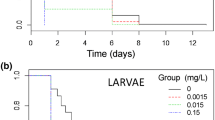Abstract
In laboratory tests, the planarianDugesia dorotocephala (Woodworth) was exposed to temephos (0.001 ppm), fenthion (0.003, 0.0035 and 0.004 ppm), malathion (0.1 ppm), chlorpyrifos (0.001 and 0.004 ppm), methoprene (0.005 ppm) and Dimilin ® (0.005 ppm) for 24 h without producing recognizable immediate or delayed effects to the viability, behavior, and asexual reproductive capacity of this planarian.D. dorotocephala tolerated relatively high concentrations of the pesticides and growth regulators suggesting their potential for integrated mosquito control.
Post-exposure observations concerning the asexual reproductive capacity ofD. dorotocephala that were initially reared in water with a chloride content of 1200–1500 ppm (type 1 planaria) and 780–870 ppm (type 2 planaria) before experimentation indicated that the degree of asexual reproduction of type I planaria was significantly greater than was observed with type 2 planaria. These results would indicate the possibility of artificially stimulating asexual reproduction, hence mass production by stressingD. dorotocephala in some pesticides and growth regulators and/or by subjecting them to changes in chloride or salinity levels.
Résumé
En laboratoire, la planaireDugesia dorotocephala (Woodworth) a été soumise à du temephos (0,001 ppm), fenthion (0,003; 0,0035 et 0,004 ppm), malathion (0,1 ppm), chlorpyrifos (0,001 et 0,004 ppm), methoprene (0,005 ppm) et à du Dimilin® (0,005 ppm) pendant 24 heures sans montrer d'effets immédiats ou différés sur la survie, le comportement et le pouvoir de reproduction asexuée. La tolérance deD. dorotocephala à des concentrations relativement élevées de pesticides et de régulateurs de croissance rend cette planaire intéressante pour la lutte intégrée contre les moustiques.
Des observations, ultérieures au traitement, relatives au pouvoir reproducteur des planaires élevées avant l'expérimentation dans de l'eau contenant 1200–1500 ppm de chlorures (planaires du type 1) et 780–870 ppm (planaires du type 2) indiquent que le taux de reproduction asexuée du type 1 est significativement plus élevé que chez le type 2. D'après ces résultats il serait possible de stimuler la reproduction asexuée, donc la production deD. dorotocephala par un traitement avec certains pesticides et régulateurs de croissance et/ou en recourant à des modifications de la salinité de l'eau d'élevage.
Similar content being viewed by others
References
Anonymous. — 1970. Instructions for determining the susceptibility or resistance of mosquito larvae to organophosphorous and carbamate insecticides. —W.H.O., Tech. Rep. Ser. no 443.
Legner, E. F. &Medved, R. A. — 1972. Predators investigated for the biological control of mosquitoes and midges at the University of California, Riverside. —Proc. Calif. Mosq. Control. Assoc., 40, 109–111.
—— 1974. Laboratory and small-scale field experiments with planaria [Tricladida, Turbellaria] as biological mosquito control agents. —Proc. Calif. Mosq. Control Assoc., 42, 79–80.
Medved, R. A. &Legner, E. F. — 1974. Feeding and reproduction of the planarian,Dugesia dorotocephala (Woodworth), in the presence ofCulex peus Speiser. —Environ. Entomol., 3, 637–641.
Rathburn, C. B. &Boike, A. H., Jr. — 1975. Laboratory and small plot field tests of Altosid® and Dimilin® for the control ofAedes taeniorhynchus andCulex nigripalpus larvae. —Mosq. News, 35, 540–546.
Author information
Authors and Affiliations
Rights and permissions
About this article
Cite this article
Levy, R., Miller, T.W. Tolerance of the planarianDugesia dorotocephala to high concentrations of pesticides and growth regulators. Entomophaga 23, 31–34 (1978). https://doi.org/10.1007/BF02371988
Issue Date:
DOI: https://doi.org/10.1007/BF02371988




